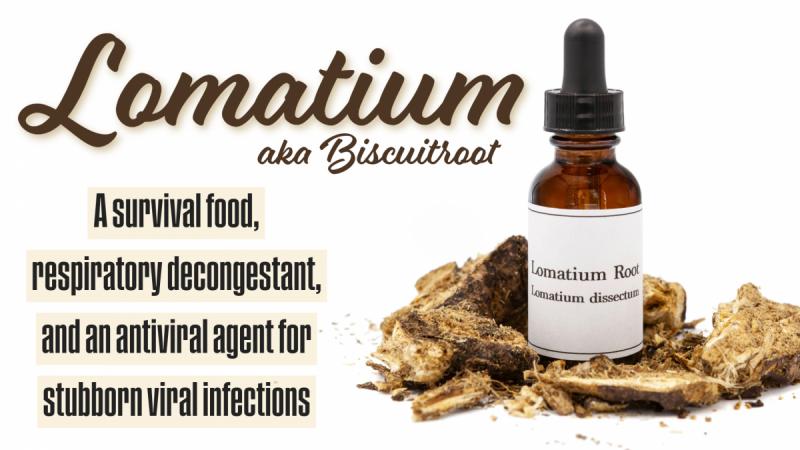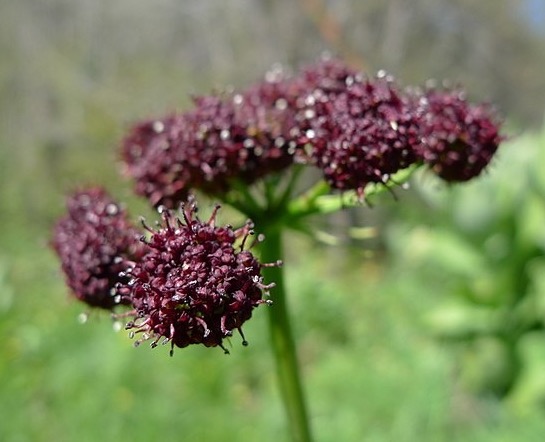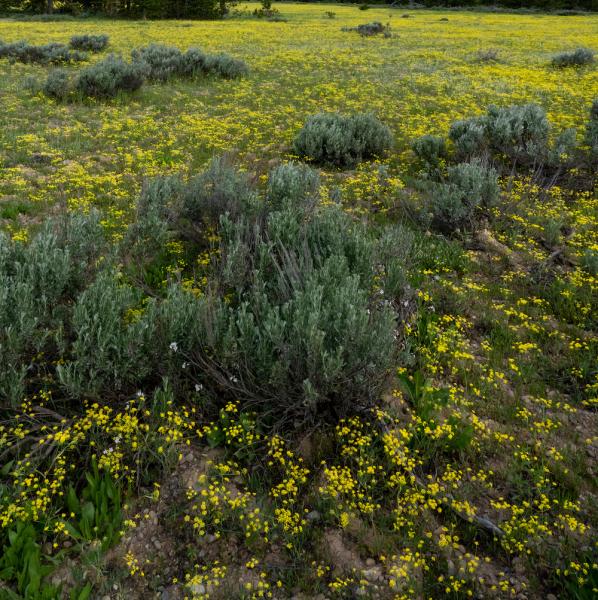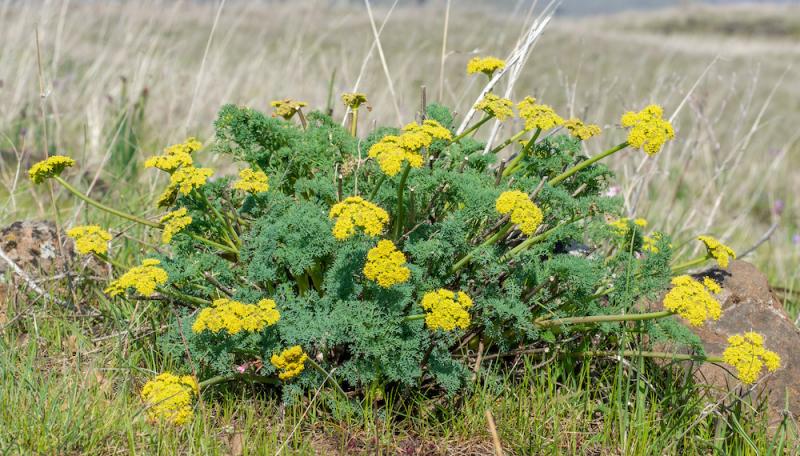
I first identified Lomatium dissectum as a teenager when I was learning about edible and medicinal wild plants. I found it growing in the foothills around Salt Lake City where I lived. Although my field guide listed it as an edible plant, I never dug any up because it is a member of the parsley family, which contains a number of poisonous plants, and I wasn’t too confident in my botanical abilities back then.
As an adult, when I had more confidence in my botanical abilities, I wanted to harvest some, but could never find it in the hillsides in the other places where I have lived. I did see some along the trail when visiting the Red Cliffs Botanical Garden in the spring of 2023, but I certainly couldn’t dig it up there.
Lomatium as Medicine
However,  I do have experience using lomatium as medicine. I first tried the remedy in the late 1980s. At the time I had a young family and I treated all my kids with herbs whenever they got sick. I found herbal remedies so effective that we almost never had to take a child to a doctor for anything.
I do have experience using lomatium as medicine. I first tried the remedy in the late 1980s. At the time I had a young family and I treated all my kids with herbs whenever they got sick. I found herbal remedies so effective that we almost never had to take a child to a doctor for anything.
I added a lomatium extract whenever they had a viral infection that wasn’t responding to my usual remedies: Children’s Composition, ALJ (a commercial lung formula), lobelia, and garlic oil. I discovered it was really helpful for resolving stubborn viral infections, something other herbalists who have used it have also noted.
Lomatium is helpful for viral-related respiratory problems, including sinus congestion, sinusitis, coughs, bronchitis, asthma, pneumonia, and tuberculosis. It’s can also helpful for respiratory allergies (hay fever), sore throats, and urinary tract infections.
Where it really excels, however, is in treating chronic viral infections such as HIV, HPV, mononucleosis, and any other viral infections that seem hard to irradicate. It also has antibacterial properties, and it has also been reported to be helpful for Lyme disease. The entire plant has been used for medicine. A tea can be made from the leaves, stems, and flowers, and a decoction can be made from the root.
The Lomatium Genus
 While Lomatium dissectum is the most widely recognized and used species, it isn’t the only useful species of Lomatium. The entire genus consists of about 100 recognized species according to Plants of the World Online. All species are reported to be edible and quite a few have been used as medicine. According to Native American Ethnobotany by Daniel E. Moerman, these include Lomatium ambiguum, L. californicum, L. canbyl, L. cous, L. foeniculaceum, L. graveolens, L. microcarpum, L. nudicaule, L. orientale, L. triternatum, and L. utriculatum. This does not include some additional species that were reported to be used only as food. Most of these species are native to the Rocky Mountain region of North America.
While Lomatium dissectum is the most widely recognized and used species, it isn’t the only useful species of Lomatium. The entire genus consists of about 100 recognized species according to Plants of the World Online. All species are reported to be edible and quite a few have been used as medicine. According to Native American Ethnobotany by Daniel E. Moerman, these include Lomatium ambiguum, L. californicum, L. canbyl, L. cous, L. foeniculaceum, L. graveolens, L. microcarpum, L. nudicaule, L. orientale, L. triternatum, and L. utriculatum. This does not include some additional species that were reported to be used only as food. Most of these species are native to the Rocky Mountain region of North America.
The flowers of Lomatium dissectum can be either yellow or purple and it can be difficult to tell the different species apart. My opinion is that many of the species aren't really distinct species but just variations of the same plant. As long as the species has a strong aromatic, pungent quality to the root, it is probably valuable medicinally. Lomatium dissectum has the advantage of growing in large patches, such as the yellow lomatium flowers seen in the picture on the right, which means you can safely harvest some of the plants leaving plenty of plants to repopulate the species. The species in the photo below is Gray's lomatium (Lomatium greyi) and is pretty typical of what lomatium species look like.
Native American Uses of Lomatium
Native Americans used lomatium primarily for respiratory ailments. These include coughs, colds, hay fever, bronchitis, flu, pneumonia, and tuberculosis. Blackfeet long-distance runners chewed seeds to avoid respiratory problems and side cramps while running. A decoction of the root was taken internally and the above-ground portion of the plant was smoked or burned and inhaled for respiratory problems.
The plant was also used topically. The decoction was also applied to cuts, sores, and rashes; the oily sap was placed on skin lesions. The raw root was chewed for sore throat and used as a poultice for swellings, sprains, and rheumatism.
Lomatium (Biscuitroot) as Food
 Lomatium can be found growing in dry, rocky soils or bushy hillsides. The root can be deep, up to four feet. So, it may not be that easy to dig up. Having tried to dig up edible and medicinal roots with a shovel, I sometimes marvel that Native Americans could dig these plants up with hardened sticks!
Lomatium can be found growing in dry, rocky soils or bushy hillsides. The root can be deep, up to four feet. So, it may not be that easy to dig up. Having tried to dig up edible and medicinal roots with a shovel, I sometimes marvel that Native Americans could dig these plants up with hardened sticks!
Native Americans ate the roots raw or boiled, but they most often dried them and pounded them to make flour, hence the common name biscuitroot. In my experience with edible plants, there is a difference between edible and palatable. Some wild foods have a pleasant taste and I will readily eat them. Most Lomatium species have strong medicinal flavors, so while they may be edible, they aren’t palatable.
The roots are very aromatic, with a peppery aftertaste, so I'd assume that much of the medicinal value of the plant is in its essential oils and pungent resins. This makes for great medicine, but as a food, it would be an acquired taste. I figure you’d have to be pretty hungry to be willing to eat them.
Harvesting and Using Lomatium
Lomatium roots are typically harvested in the fall, but that’s also the time when it’s more difficult to make a positive identification. Therefore, it’s easier to harvest the plant when it’s in bloom because the flowers make it easier to make the most positive identification.
In Medicinal Plants of the Mountain West, Michael Moore says the spring roots (when the plant is in flower) have a milky sap that is bitter and aromatic In nature. As the roots mature in the fall, they become more resinous and balsamic. The spring roots are best for making a fresh plant tincture (1:2 ratio with 70% alcohol), while the fall roots are better for drying and making dried root tinctures (1:5 ratio with 70% alcohol).
Personally, I use a commercially prepared lomatium tincture. The dose is small 10-30 drops up to five times a day. As previously mentioned, I combine it with my Children’s Composition formula and a respiratory decongestant for respiratory problems. For bacterial infections, it works well with echinacea. If I was using it for Lyme disease I would combine it with andrographis.
Downloads
Steven's Articles
-

-
Barberry and Healthy Personal Boundaries
A thorny shrub for fighting infections and supporting…
December
-

-
The Evidence for Berberine
A yellow alkaloid found in traditional infection-fighting…
-

-
The Sensible Use of Caffeinated Herbs
Kola nuts, guarana, and yerba mate and other herbs…
-

-
The Health Benefits and Problems with Coffee
This popular caffeinated beverage can be beneficial…
October
-

-
Understanding Caffeine & Cellular Adaptation
Preserving the power of caffeine's buzz and the…
September
-

-
Horseradish
A pungent spice for aiding protein metabolism…
-

-
Banaba or Crepe Myrtle
A beautiful tree from Southeast Asia whose leaves…
August
-

-
Monkeyflowers
Flower essences to help see ourselves more clearly…
-

-
Mariposa Lilies
Strengthening the bond between mother and child…
-

-
The Noble Bay Leaf
A common kitchen herb for aiding digestion and…
-

-
Epimedium: Horny Goat Weed
A circulatory stimulant and kidney yang tonic…
July
-

-
The Medicinal and Nutritional Benefits of Apricots
A nutritious fruit and valuable medicinal seed for coughs
-

-
Dogwoods
Asian dogwood is used to stop excessive discharge,…
June
-

-
Neem: The Village Pharmacy
A popular Ayurvedic remedy for dental and immune…
-

-
Spilanthes: The Toothache Plant
A traditional remedy for teeth and gums, as well…

